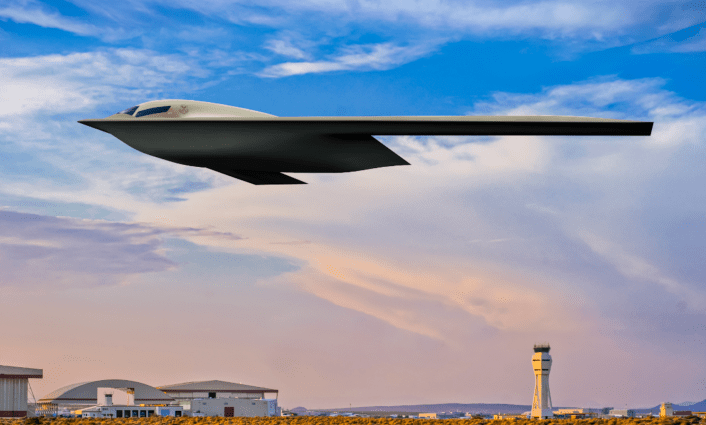The US has announced that its next-generation stealth bomber is now slated for production, signaling a new era in aerial warfare and strategic deterrence amid renewed great power competition with China and Russia.
Several news outlets reported that the B-21 Raider stealth bomber, the next-generation aircraft of the US Air Force, is now ready for production by defense contractor Northrop Grumman.
US Undersecretary of Defense for Acquisition and Sustainment William LaPlante confirmed that the B-21 production is moving forward based on ground and flight tests and mature plans for manufacturing. That’s a fast timeline considering the aircraft passed its initial flight testing just two months ago.
The B-21 will replace the B-1B Lancer and B-2 Spirit and is expected to enter service in the mid-2020s. The US Air Force plans to buy at least 100 of the aircraft, according to the reports. The US Air Force Rapid Capabilities Office (AFRCO) is managing the acquisition program, which puts the bomber on a faster track than previous fielding of new aircraft.
The B-21 is designed to reduce risk by pairing mature and semi-mature systems with an advanced airframe that leverages lessons learned from other programs. The aircraft is part of a family of systems, including the Long-Range Stand-Off (LRSO) stealthy nuclear-tipped cruise missile and the RQ-180 strategic reconnaissance drone.
The first operational squadron of B-21s is anticipated to be stationed at Ellsworth Air Force Base in South Dakota. At the same time, Whiteman Air Force Base in Missouri and Dyess Air Force Base in Texas are expected to host future squadrons.
While the B-1B and B-2 were designed to penetrate heavily defended Soviet airspace, wear and tear, evolving enemy defenses and cost spiral have made developing a next-generation bomber more practical.
The B-1B was designed as a nuclear-capable supersonic bomber at high altitudes and a low subsonic aircraft at low altitudes to evade Soviet air defenses. While it was never used in its intended role, it was invaluable for providing close air support for US troops in Iraq and Afghanistan.
Its supersonic capability meant that it had a faster response time than other available aircraft and was less vulnerable since it flew beyond the reach of insurgent anti-aircraft fire.
However, the protracted wars in Iraq and Afghanistan meant that the B-1B airframes were exposed to a high rate of wear and tear, leading to the type’s planned early retirement in the 2030s.

The B-2 bomber was designed as a high-subsonic, nuclear-capable stealth bomber capable of striking deep into Soviet territory. While the US planned to acquire 132 B-2 units, the end of the Cold War and spiraling costs meant only 21 B-2s were built.
Also, since the B-1B and B-2 have been designed with Soviet-era air defenses in mind, they may now be vulnerable to newer Russian and Chinese air defenses and fighter aircraft such as the S-400 surface-to-air missile (SAM) system and J-20 stealth fighter, meaning that America’s bomber force may not be able to penetrate near-peer adversary airspace.
In a March 2023 report by the Mitchell Institute for Aerospace Studies, Mark Gunzinger mentions that long-range penetrating strikes can be accomplished by stealthy aircraft that can operate in contested areas, while non-stealth platforms such as ships, ground launchers and non-stealth aircraft can perform stand-off strikes while remaining outside contested areas.
Gunzinger notes that non-stealth platforms cannot operate in dense anti-access/area-denial (A2/AD) areas with acceptable risk and that stand-off strikes cannot replace penetrating stealth bombers, as only the latter have the survivability and mission persistence to locate, track, and strike large numbers of mobile or relocatable targets such as warships or surface-to-surface missile launchers.
He notes that penetrating bombers are sensor-shooter nodes that can organically close kill chains against mobile or relocatable targets, in contrast to other stand-off strike systems that rely on off-board sensors and data links in environments where such capabilities may be degraded.
Gunzinger adds that only bombers have the payload capacity to carry large bunker-busting bombs against hardened or deeply buried targets, such as underground missile storage facilities, runways and command and control bunkers used by China, Russia, and North Korea.
He mentions that missiles cannot carry such large payloads without prohibitive costs, which makes target hardening a viable countermeasure against missile strikes. In terms of nuclear deterrence, Gunzinger notes that in a crisis bombers can be postured to reduce their response times and dispersed to multiple bases to reduce their vulnerability to attacks.
He also says that bombers are the most visible leg of the US nuclear triad and that their ability to launch, remain on airborne alert and be redirected or ordered to proceed with their nuclear strike missions up to the last moment provides options to signal national resolve in a way land-based intercontinental ballistic missiles (ICBM) or submarine-launched ballistic missiles (SLBM) cannot.
Gunzinger recommends upsizing the US bomber fleet by keeping existing aircraft in service or scaling up B-21 production. He notes that the current US bomber fleet of 141 aircraft may not be able to deploy enough sorties to blunt and defeat a Chinese invasion of Taiwan while deterring Russia, replace bombers lost in combat and maintain a credible air-based nuclear deterrent.

The B-21 is expected to perform a significant role in the US forward-deployed airpower posture in the Pacific, with multiple island bases being considered to host the next-generation bomber.
In a Forbes article this month, Eric Tegler mentions that B-21s flying from US Air Force Base Andersen in Guam, Royal Australian Air Force (RAAF) Base Darwin, RAAF Base Townsville, or RAAF Base Amberley can hold most of mainland China and all of North Korea within range, with a revived US airbase at Tinian Island providing additional possibilities.
Tegler notes that paring forward-deployed B-21s with land-based missiles deployed on US and allied territories in the Pacific, alongside ship and submarine-launched missiles, could make a potent deterrent force.

